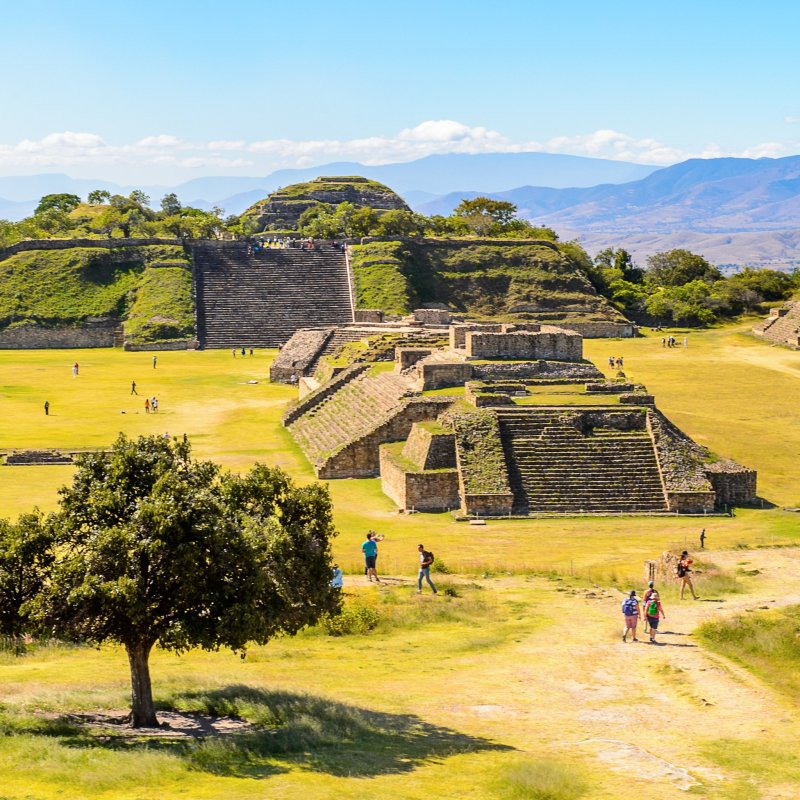
Once the capital of the Zapotec civilization, the ancient city of Monte Alban, at least what is left of it, still overlooks the Valley of Oaxaca. One of Mexico’s best-preserved and most culturally rich archaeological sites, it features remains of palaces and temples, steep platforms, a ball court, and an observatory with great views of small towns in the surrounding valleys, plus distant mountains and the vibrant city below.
Videos by TravelAwaits
Inhabited for over 1,500 years, Monte Alban was home to a diversity of ancient people, from the Olmecs to Zapotecs and Mixtecs, but it flourished during the time it was the capital of the Zapotec civilization between 500 B.C. and 850 A.D. Abandoned long before the Spanish arrived in the area, the ancient city’s monuments still stand witness to its long history.
No matter what your reason is for visiting Oaxaca City, you must include a tour of the ruins on the hilltop. Though usually busy, the site doesn’t get overcrowded, so you will have a pleasant visit whenever you go.

Where Is Monte Alban?
Designated a UNESCO World Heritage Site in 1987, Monte Alban sits on a 1,300-foot high hilltop in the Valley of Oaxaca, a depression between the Sierra Madre Oriental and the Sierra Madre del Sur in the state of Oaxaca.
Only a few miles from downtown Oaxaca, the city bus rides up the mountain. It takes about 30 minutes. But taxis abound, and if you’d rather not deal with trying to find your way through bus stations, you can find them lined up in the center of town. Or flag one on any street corner.
Pro Tip: Unless you ask them to wait for you, the taxi drivers drop you off at the site and leave, taking other visitors back into town. To get back, you’ll need to catch another one who just brought someone up. If you want your driver to wait for you, don’t forget to ask.
Another option for getting to the ruins is to take a shuttle; you can book one at your hotel or at the shuttle office in the Zocalo.
Or, take a guided tour. This is an especially good idea if you speak Spanish and want a local perspective. Your hotel can arrange a tour for you, or you can find a local guide in the center of Oaxaca.

The Importance Of Monte Alban: A Pre-Columbian Cultural And Economic Center
One of the most studied archaeological sites in Mexico, Monte Alban was a large social and cultural center, the capital of the ancient Zapotec civilization. The descendants of the Zapotecs still live in the area, though they abandoned their ancient capital city around 850 A.D., centuries before the Spanish arrived.
Sitting high above its surrounding populated valleys, Monte Alban is a very visible site. It was most likely used for ceremonies and grand events, rather than for permanent residences since the closest water source is four miles away. Even in ruins, its imposing structures and large-scale architecture still inspire awe. Walking through the site, you can’t help but wonder how the ancients built them to withstand centuries in the earthquake-prone area.
Start Your Visit At The Museum
A small museum at Monte Alban’s entrance showcases a few artifacts from the site. The exhibits include a few of the carved stone slabs called danzantes (you’ll see more of them outside), pottery, small sculptures, and relics found in tombs at the site.
Walking through its rooms gives you an idea of the history, timeline, and structures you’ll see as you tour the ancient city.

Explore The Great Plaza
Past the entrance area, you’ll follow a slightly uphill trail to the main area of the site, known as the Great Plaza, which was once the center of the city. Take a moment to enjoy the view of the site and of the valleys below.
Entering the plaza from its northeastern edge, the best way to explore it is to walk clockwise through the east side toward the southern edge, stopping at the central structures, then circling back up the western side.
If you follow this path, the first structure you’ll see is the ball court, where the ancients played their game, which had religious significance in addition to being a sport.
As you continue your tour, you’ll find a series of structures and platforms with wide stairs. After a stop, walk toward the center of the plaza. Here, you’ll find the Palace, a cluster of buildings surrounding a courtyard and, past it, the Observatory.
Shaped like an arrow pointing southwest, the Observatory features stone slabs identified as conquest stones embedded in its walls. They depict place names, sometimes accompanied by upside-down heads and more writing. These are the names and representations of places Monte Alban conquered during its heyday. Archaeologists identified a few of these cities, and in one case, confirmed the conquest.
Moving on, you’ll reach the southern end of the Great Plaza and the South Platform. To get to the top, you have to climb some stairs. Other than a great view of the plaza, you miss little if you skip the climb. Instead, stop to admire the carved stelae incorporated into its base and move on.
Surrounded by two pyramids, you’ll get to the most famous site in Monte Alban.

Los Danzantes Of Monte Alban
Past the first pyramid, you reach the Danzantes Gallery and building, the most interesting place at the site. About 300 of the stone slabs, called danzantes, were found here, and some of them still stand in their original places. Some are incorporated into the walls of the building; others are standing around it.
Though the name suggests that the stone slabs depict dancers, this idea has been discredited in recent years. Today, the accepted theory is that the “dancers” are sacrificial victims or war prisoners; their bodies are shown distorted and mutilated by torture. No matter what you see in them, they are still interesting from an artistic point of view.
Explore The North Platform
Pass the second pyramid surrounding the danzantes, and you’ll find yourself back at the North Plaza. A large, reconstructed stairway leads to the top. At its bottom, you’ll see Stela 9, an obelisk carved on all four sides. Almost as large as the Great Plaza, the North Platform features a ceremonial area that includes an altar.
You can get around climbing the stairs by walking around where you first entered the Great Plaza and going up a hill on the side of the platform.
From here, you can exit the site or walk over to the tombs.

The Tombs Of Monte Alban
If you still have energy and want to visit some of Monte Alban’s tombs, follow the trail from the northern edge of the North Platform. It’s a nice walk, some of it shaded by mature trees, and you can find some solitude on this side since few visitors go back this far. You’ll see a few tombs, but they are all locked, so you can’t go inside. Their artifacts are in museums away from the site.
Pro Tip: Stop at the museum again on your way out. After seeing the site, the exhibits gain a new meaning.
Monte Alban Tips And Practical Information
Even if you don’t climb any of the structures and decide to stay in the Great Plaza, you will have some walking to do, so wear comfortable walking shoes.
It is usually hot and humid in and around Oaxaca, no matter when you go, so dress in light clothing. The best time to visit is in the winter when temperatures are lower and the weather is more pleasant. In the summer it can get very hot and you’re more likely to encounter rain, but the surroundings are greener.
No matter when you go, you won’t find much shade, so you need a hat, sunscreen, and water. If you forget a hat, buy one at the entrance before you start exploring the site. It will be worth it.
Pro Tip: Since Sunday entrance is free for Mexican citizens and residents, it is usually the busiest day at Monte Alban. Though the site most likely won’t feel overcrowded since it is so large and open, if you want to share the views with fewer visitors, go mid-week.
Interested in ruins? Don’t miss “Beyond Chichen Itza: Maya Ruins In The Yucatan Worth Visiting.”
